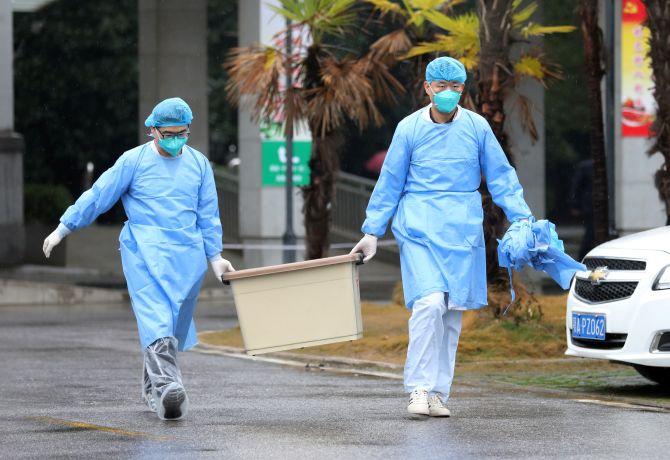Source: PTI - Edited By: Utkarsh Mishra
January 21, 2020 23:42 IST

IMAGE: Medical staff carry a box as they walk at the Jinyintan hospital, where the patients with pneumonia caused by the new strain of coronavirus are being treated, in Wuhan, Hubei province, China. Photograph: Stringer/Reuters
The coronavirus (CoV) is a large family of viruses that causes illnesses ranging from the common cold to acute respiratory syndromes, but the virus that has killed four people in China is a novel strain not seen before.
Common symptoms of the novel coronavirus (nCoV) strain, which has infected more than 300 people since the outbreak in Wuhan in December, include respiratory symptoms such as fever, cough, shortness of breath and breathing difficulties, the World Health Organisation (WHO) said.
In more severe cases, infection can cause pneumonia, severe acute respiratory syndrome, kidney failure, and even death.
"Initial available data indicates that the novel Coronavirus-2019 (2019-nCoV) appears to cause less mortality than SARS CoV and MERS CoV. The disease manifestation ranges from asymptomatic to severe," G Arunkumar, director of the Manipal Institute of Virology, told PTI.
"As per the available limited information, initial transmission appears to be zoonotic origin, though the source is yet be identified. There is report of human to human transmission in the press but needs to be confirmed by authentic sources," he said.
The discovery of a novel strain of the virus in China has compelled nations to quarantine passengers from the country and issue travel advisories, while prompting the WHO to convene an emergency meet on the matter.
Countries around the world have sounded an alert following the confirmation of the first case of human-to-human transmission of the deadly infectious disease.
Cases have been detected in Thailand, Japan and South Korea.
India has instructed screening of travellers from China at airports in Delhi, Mumbai, and Kolkata via thermal scanners.
'The Emergency Committee on the novel #coronavirus (2019-nCoV) will ascertain whether the outbreak constitutes a public health emergency of international concern, and what recommendations should be made to manage it,' WHO tweeted on Tuesday ahead of the meeting.
How are coronoviruses spread?
Coronaviruses are zoonotic, meaning they are transmitted between animals and people, according to the WHO.
Several known coronaviruses are circulating in animals that have not yet infected humans.
On December 31, 2019, the WHO China Country Office was informed of mysterious cases of pneumonia detected in Wuhan City in China's Hubei Province.
The novel coronavirus (2019-nCoV) was identified as the causative agent by Chinese authorities on January 7.
The WHO has offered guidance to countries on how they can prepare for it, including monitoring the sick, and treating patients.
This includes protocols for testing samples, treating patients, controlling infection in health centres, maintaining the right supplies, and communicating with the public about this new virus.
According to the US Centers for Disease Control and Prevention (CDC), human coronaviruses most commonly spread from an infected person to others through the air by coughing and sneezing, close personal contact, such as touching or shaking hands.
The viruses can also spread by touching an object or surface with the virus on it, then touching your mouth, nose, or eyes before washing your hands, the CDC said.
In pregnant women, the more severe versions of MERS and SARS coronaviruses can be serious. According to a case study published in 2014 in The Journal of
Infectious Diseases, a woman infected with MERS had a stillbirth.
Till date, there is no vaccine to protect against this family of viruses.
However, based on currently available information, the WHO does not recommend any restriction on travel or trade.
'Countries are encouraged to continue strengthening their preparedness for health emergencies in line with the international health regulations,' the WHO said in a statement.
It said standard recommendations to prevent infection spread include regular hand washing, covering mouth and nose when coughing and sneezing, thoroughly cooking meat and eggs.
WHO also advises that people should avoid close contact with anyone showing symptoms of respiratory illness such as coughing and sneezing.
Source: PTI - Edited By: Utkarsh Mishra
© Copyright 2020 PTI. All rights reserved. Republication or redistribution of PTI content, including by framing or similar means, is expressly prohibited without the prior written consent.
used here for educational purposes only.
No comments:
Post a Comment